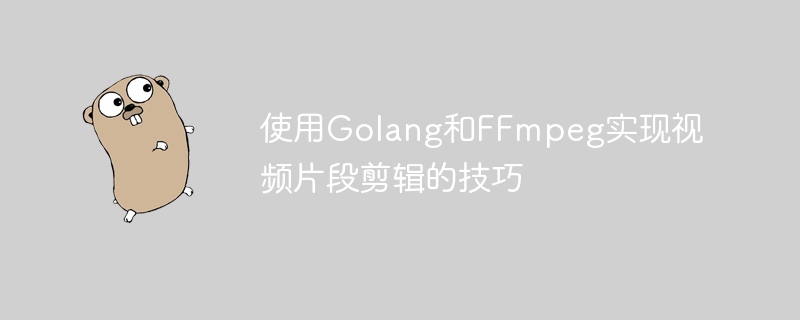

Tips of using Golang and FFmpeg to implement video clip editing
Introduction:
In the era of modern social networks and multimedia platforms, the demand for video editing is increasing more. Whether you are making short videos, movie clips or video tutorials, you need to edit video clips. This article will introduce how to implement video clip editing techniques by using the Golang programming language and the FFmpeg tool, with specific code examples.
1. Install FFmpeg
Before we begin, we need to install the FFmpeg tool first. FFmpeg is a cross-platform multimedia framework that can encode, decode, transcode, mix, multiplex, stream, decompose, splice, etc. It can be installed through the official website (https://ffmpeg.org/) or package management tools (such as apt, yum, etc.).
2. Understand the command line parameters of FFmpeg
FFmpeg provides a wealth of command line parameters to meet various video processing needs. In this article, we focus on the following parameters:
3. Use Golang to call FFmpeg
In Golang, we can use the os/exec package to call the FFmpeg command line tool. The following is a sample code that demonstrates how to call FFmpeg for video editing in Golang:
package main
import (
"log"
"os"
"os/exec"
)
func main() {
// 设置FFmpeg的命令行参数
args := []string{
"-i",
"input.mp4",
"-ss",
"00:01:00",
"-t",
"00:00:10",
"-c:v",
"copy",
"-c:a",
"copy",
"output.mp4",
}
// 调用FFmpeg命令行工具
cmd := exec.Command("ffmpeg", args...)
// 设置命令行工具的输出和错误输出
cmd.Stdout = os.Stdout
cmd.Stderr = os.Stderr
// 执行命令行工具
err := cmd.Run()
if err != nil {
log.Fatal(err)
}
}In the above code, we first define a slice args to store the command line parameters of FFmpeg. Then, create a cmd object by calling the exec.Command method and pass args to it as arguments. Next, we set the output and error output of cmd, which are os.Stdout and os.Stderr respectively. Finally, call the cmd.Run method to execute the command line tool and check for errors.
4. Practical Application
Through the above code, we can simply implement the video editing function. Here is an example of practical application: split a video file into multiple small fragments and save them as different files.
package main
import (
"fmt"
"log"
"os"
"os/exec"
"path/filepath"
)
func main() {
// 设置FFmpeg的命令行参数
args := []string{
"-i",
"input.mp4",
"-c:v",
"copy",
"-c:a",
"copy",
}
// 视频片段的开始时间点和时长
clips := []struct {
startTime string
duration string
}{
{"00:00:00", "00:00:10"},
{"00:00:10", "00:00:15"},
{"00:00:25", "00:00:20"},
}
for i, clip := range clips {
// 设置输出文件名
outputFilename := fmt.Sprintf("output-%d.mp4", i)
// 添加剪辑的开始时间点和时长到命令行参数
args = append(args, "-ss", clip.startTime, "-t", clip.duration, outputFilename)
// 调用FFmpeg命令行工具
cmd := exec.Command("ffmpeg", args...)
// 设置命令行工具的输出和错误输出
cmd.Stdout = os.Stdout
cmd.Stderr = os.Stderr
// 执行命令行工具
err := cmd.Run()
if err != nil {
log.Fatal(err)
}
// 清空命令行参数,准备下一个视频片段
args = args[:len(args)-4]
}
fmt.Println("视频剪辑完成!")
}In the above code, we first define a structure clips to store the start time and duration of the video clip. Then, through a for loop, each video clip is edited in turn and saved to a different file. In each loop, we add the starting time point and duration as parameters to args, and after executing cmd.Run, clear the previously added parameters through args[:len(args)-4] to prepare for the next Editing of video clips.
Conclusion:
By using Golang and FFmpeg tools, we can easily and efficiently implement the function of editing video clips. Golang provides the ability to call external command line tools, while FFmpeg provides rich video processing functions. I hope this article can help readers better understand and apply these two tools and achieve more interesting video editing effects.
The above is the detailed content of Tips for editing video clips using Golang and FFmpeg. For more information, please follow other related articles on the PHP Chinese website!




